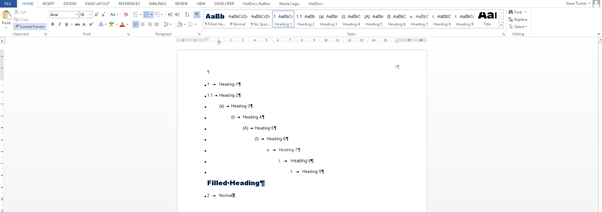An issue that affects almost every organisation that we have worked with is formatting of their Word templates.
In most cases they are consistently inconsistent and terrible.
It not only reflects badly on the organisation and how the substance of the document may be perceived, but it’s a huge cost as it takes a lot of time for highly paid staff to fix, and refix, formatting each time a document is created.
Documents have often been cobbled together over time, and often have many of the following issues:
- Different font types, sizes and formatting
- Unstable and inconsistent numbering (and cross referencing)
- Different layouts
- Corrupted styles that arise from copying and pasting between different documents.
A quick look at the template properties and style gallery will often give a glimpse of where the document originally came from, and which other organisations have contributed content and formatting via copy and paste over time.
Because the styles haven’t been set systemically, people resort to manual work-arounds to try and spot fix issues while never addressing the root cause.
For example, to try and align paragraphs and numbering, or achieve right alignment, we regularly see attempts to use a series of tabs to achieve it, but then when text is added, the alignment screws up.
Some documents still contain hard-coded numbering, which doesn’t adjust at all when new paragraphs are added or deleted. Other numbering is unstable, so when a new paragraph is added, the numbering doesn’t follow the numbering before it. Or it continues from an earlier numbering list, when it should be restarting.
Rather than use paragraph spacing to achieve gaps between paragraphs, we frequently see use of hard returns which is an unnecessarily complication.
You will often see dozens of styles in the style gallery. Many of these will never be used, which is good as they have often become corrupted over time by being mixed with styles from other organisations.
What is the solution?
I am not an expert on Word styles, but I was fortunate to work in a law firm that generally had good controls over its Word styles, and was able to learn some of the key good practices. I’ve also done my own basic research, and found helpful resources like this one from Shauna Kelly: How to create numbered headings or outline numbering
With this background, I have created two simple templates that we use in LawHawk when creating our own documents.
There’s one for agreements (which need a larger Heading 1) and one for other documents such as letters, which need simpler paragraph numbering.
In general, I try and use as few styles as possible, because it’s much easier to maintain control and consistency. You can see them, and how they translate into the documents, below.
For Agreements:

For letters and other documents:

If you have a small number of styles, that you use consistently, it becomes a lot easier to update them. You can see how easily it can be done in this video:
How does this help you?
As the video shows, once you have simple templates that have the key styles that you want to use, it’s easy to customise them further.
Knowing that not everyone has the time or inclination to build their own templates, I’ve made ours available for download which you can do here:
These are not perfect, but if you don’t currently have document templates, or the ones you have are beyond repair, please feel free to download these templates. You can use them as they are, customise them as you want following the instructions in the video, or just use them to see how Shauna Kelly’s approach works and to create your own.
If you have any issues, or thoughts on how the templates could work better, please let me know!